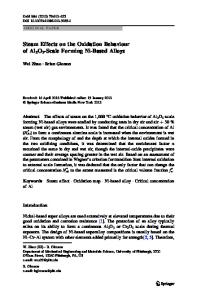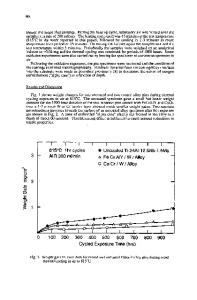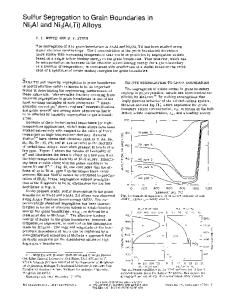The relationship between mass transport and oxide chemistry in oxidation of Ni 3 Al alloys
- PDF / 1,024,283 Bytes
- 9 Pages / 576 x 792 pts Page_size
- 23 Downloads / 256 Views
Isotope diffusion and surface analysis has been used to investigate mass transport processes and oxide chemistry during oxidation of Ni3Al alloys in oxygen between 450 and 800 °C. In all cases, the oxide has an outer layer rich in NiO that grows by outward metal diffusion. Below 650 °C, an inner mixed oxide layer allows fast inward oxygen diffusion and growth. A porous inner layer of alumina forms at 700 °C that also allows oxide growth by oxygen in-diffusion. At 800 °C, the alumina becomes protective and halts the inner oxide growth mechanism. When macroalloyed with chromium, oxide chemistry is similar, but with an additional chromium oxide in the outer layer. There is an increased oxidation protection at temperatures ^600 °C that results from the inhibition of oxygen in-diffusion as an oxidation process. Above 700 °C, however, protective alumina formation is retarded and faster outward metal diffusion enhances the oxide growth rate when compared to Ni 3 Al.
I. INTRODUCTION The ordered intermetallic, Ni 3 Al, has possible structural applications at high temperatures due to its high yield strength and resistance to oxidation in cases where it forms a protective oxide. To overcome environment related embrittlement, it has been necessary to macroalloy it with chromium,1 and this has led to an interest in oxidation processes in both alloys. For the constituent elements of these two alloys the following reactions can take place during oxidation:
higher temperatures (>1000 °C). The transport mode then changes to exclusive Cr lattice diffusion through a densified oxide scale.5 In the case of Ni 3 Al, an additional oxidation reaction may occur: Ni alloy
2Alalioy + 2O 2 = NiAl 2 O 4
(4)
As the oxidation of the nickel-aluminum alloy continues, equilibria between the oxide phases and the alloy surface are initiated. The composition and relative stability of the different oxide phases present are determined by the composition at the alloy/oxide interface because of the reactions between the oxide phases and alloy given below:
^ 0 2 = NiO
(1)
2Al alloy
- O 2 = A1 2 O 3
(2)
2Cr alloy
^ O 2 = Cr2O3
(3)
3NiAl 2 O 4 + 2Al alloy = 4A1 2 O 3 + 3Ni alloy (5) 4NiO + 2Al a n o y = NiAl 2 O 4 + 3Ni alloy (6)
In pure nickel below 900 °C, the growth of nickel oxide [Eq. (1)] is controlled by the outward diffusion of nickel along short circuit diffusion pathways.2 This is not, however, the exclusive transport process for nickel oxide growth. Nickel oxides that form a duplex structure (a dense outer layer over a porous inner layer) show evidence for the inward diffusion of oxygen contributing to growth of the porous inner nickel oxide layer.3 By contrast, the growth of AI2O3 on pure aluminum [Eq. (2)] below 900 °C is controlled by the outward diffusion of aluminum. The contribution of oxygen diffusion to aluminum oxide growth increases with temperature and impurity concentration.4 Formation of Cr 2 O 3 [Eq. (3)] in pure chromium is controlled at first by the outward diffusion of Cr through grain boundaries that - is accompani
Data Loading...











